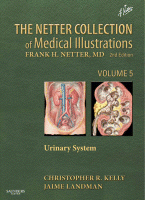Physical Address
304 North Cardinal St.
Dorchester Center, MA 02124

OSMOTIC DIURETICS ACTIONS AND MECHANISM In the nephron, water reabsorption is a passive phenomenon that relies on the transcellular osmotic gradients established during the reabsorption of solutes, especially sodium. Osmotic diuretics alter these gradients to produce diuresis. After intravenous administration,…

BENIGN RENAL TUMORS There are several different kinds of benign renal tumors, which may originate from a wide range of cell types. Solid renal tumors, however, are generally malignant, with the probability of malignancy strongly correlating with tumor size. For…

VOIDING DYSFUNCTION Urinary incontinence affects an estimated 13 million adults in the United States, 85% of whom are women. The problem is especially common among nursing home residents, affecting 50%, and older women, affecting 15% to 30% of women over…

RENAL INJURIES The kidney is injured in up to 5% to 10% of all severe trauma cases. At most urban trauma centers, approximately 80% to 90% of kidney injuries are blunt, while the remainder are penetrating. Children are more likely…

OBSTRUCTIVE UROPATHY Obstructive uropathy encompasses the numerous sequelae that may be observed when there is an anatomic or functional blockage of the natural flow of urine. Obstructions may occur at any level in the urinary tract, and the clinical signs…

CYSTITIS Urinary tract infections (UTIs) can involve the bladder alone (lower UTI, also known as acute cystitis) or extend to the renal pelvis and parenchyma (upper UTI, also known as acute pyelonephritis). If untreated, such infections can progress in vulnerable…

OVERVIEW OF ACUTE KIDNEY INJURY Acute kidney injury (AKI) consists of any precipitous decline in renal filtration function, which can occur secondary to disease affecting the renal vasculature, renal parenchyma, or urine collecting system. Such a decline is often first…

BASIC FUNCTIONS AND HOMEOSTASIS Blood enters the kidneys in a series of branching vessels that give rise to afferent arterioles. Each afferent arteriole leads to a tuft of glomerular capillaries. Plasma and small, non–protein bound solutes are filtered across the…

DEVELOPMENT OF KIDNEY The kidneys develop from the intermediate mesoderm, which is located on each side of the embryo between the paraxial (somitic) and lateral plate mesoderm. After the fourth week, during which the embryo undergoes a complex folding process,…

KIDNEY: POSITION AND RELATIONS POSITION AND SHAPE The kidneys are paired retroperitoneal organs that lie lateral to the upper lumbar vertebrae. In the relaxed, supine position, their superior poles are level with the twelfth thoracic vertebra, while their inferior poles…